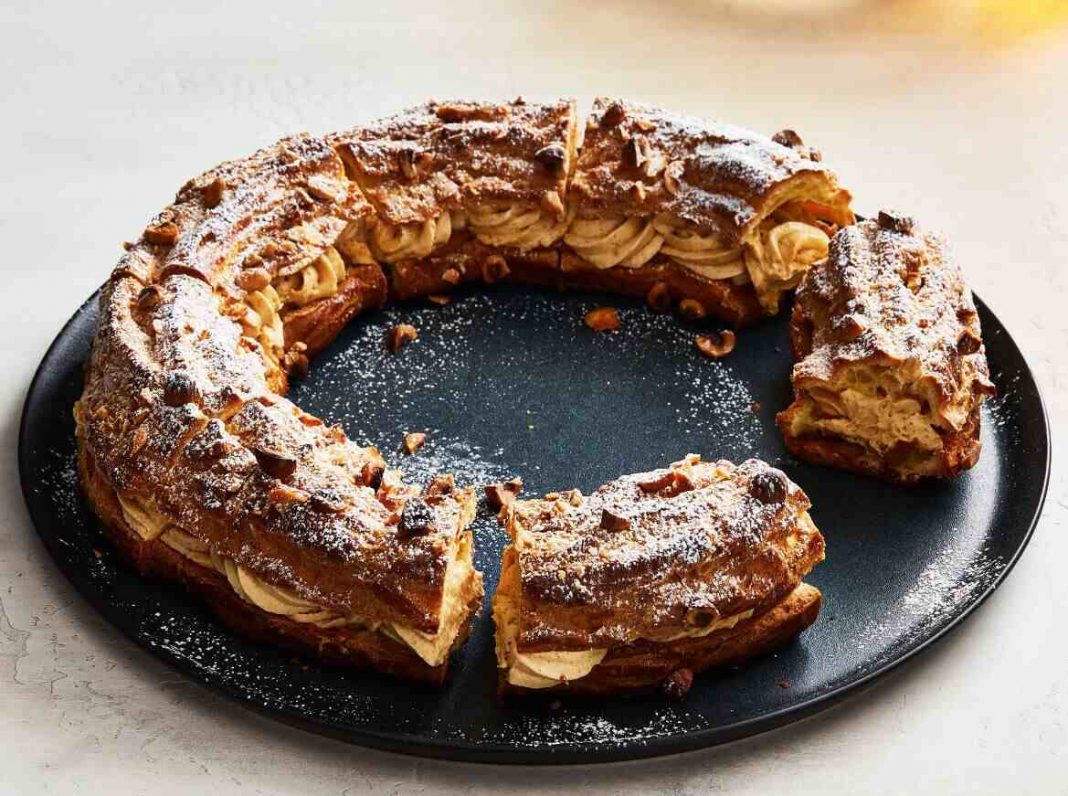Paris-Brest is the first thing that comes to mind for me when I think of French pastries; I think of it before éclairs, before madeleines, and even before the croissant. Due to the fact that I consider it to be unparalleled in terms of flavour, I place it in a unique position among the many types of baked goods.
Paris-Brest is a dessert that was first created in 1910 by the French pastry chef Louis Durand. It got its name from a bicycle race that takes place between the capital city of Paris and the port city of Brest, which is located in the northwest of France. It was also intended to have the appearance of a bicycle wheel, with its ring of pate à choux, also known as cream puff pastry, that was cut in half horizontally and filled with praline mousseline. The final product, with its juxtaposition of crunchy choux and velvety filling, is an excellent example of contrast as a teaching tool.
The preparation of a Paris-Brest, like that of many other French pastries, calls for a number of different procedures and components; however, the whole process may be broken down into more manageable pieces that can and should be completed in advance. Because the completed pastry is so impressive, you should save it for times you truly want to flaunt your skills (and feed a group).
The first thing that has to be done is to produce the praline, which is a combination of caramel and nuts that has been mixed together (typically a 50-50 mix of hazelnuts and almonds). The praline paste that is sold in stores is often smoother than the homemade kind, which is difficult to get outside of France. To make sure that my handmade praline paste is as silky smooth as it can be, I first toss roasted hazelnuts in a dark caramel, then crush the combination, and last mix the crushed mixture with almond butter that has been whipped to a silky smooth consistency in a food processor. The almond butter kick-starts the grinding process, so minimising the amount of work that has to be done by the food processor and the quantity of grit that is produced. You may prepare the praline several weeks in advance; to avoid rancidity, just keep it in the refrigerator and mix it well shortly before using it.
The next step is to produce the mousseline, which begins with the preparation of a pastry cream, which is essentially a vanilla pudding. On the stove, it is brought to a boil and let to simmer until it becomes thick and bubbly. In order to activate the cornflour, you will need to bring the liquid to a boil while whisking it the whole time. After being placed in the refrigerator for a number of hours, the pastry cream is then beaten with the praline paste and butter at room temperature until it is fluffy and smooth. This step is performed in order to assist the mousseline in maintaining its shape so that it may be piped into beautiful swirls within the pastry ring.
The pate a choux ring is the last component of this dish. It’s not always easy to make pate a choux from scratch. It must be completely cooked in two stages for the oven to provide the desired results of puffing up and hollowing out. After the milk, water, butter, and flour have been worked into a soft dough on the stovetop, the moisture is driven out of the mixture by beating eggs into the dough after it has been removed from the fire.
The oven is used for the second stage of cooking. If you don’t bake the dough for long enough, the centre will be overly moist, which will cause the dough to collapse, so let it continue to bake until the pastry is a rich golden brown colour. Remember to poke holes in the ring and let it cool inside the oven after it has been turned off. This will assist to further dry out the inside of the oven and ensure that the ring remains hollow, which is essential for separating the top from the bottom.
Fill the Paris-Brest just before serving to ensure that the pastry remains crisp, then top it off with a dusting of confectioners’ sugar not only does it look gorgeous, but it also cover any unevenness in the choux if your piping skills aren’t exceptional. As one of the challenges of serving the Paris-Brest is keeping the mousseline from squishing out of the pastry as you slice it, I pre-slice the top ring before laying it over the filling. This ensures that the mousseline stays contained inside the pastry.
You will be able to put together one of the most amazing and delectable desserts that has ever been thought of, completely stress-free, if you plan ahead and make all of the components in advance; there is truly nothing more stunning than that.

